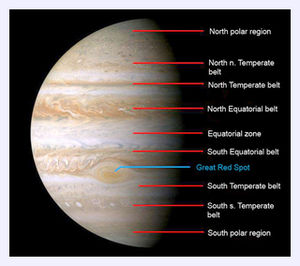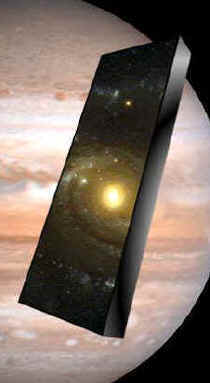Sunday morning when Jupiter and the moon came up together in the east I was tempted to remain outside with the birds and growing light and observe the planet, but it had been a long night and I desperately needed sleep. As the sun continues to move away from Jupiter, the planet will rise higher and in time become more conveniently placed for viewing. Still, intrepid sky watchers with small telescopes may want to consider making an early morning pilgrimage to the king of the planets to see for themselves how it's gotten something of a makeover.
Last winter changes were already underway as the South Equatorial Belt, one of the two most prominent dark "stripes" on the planet, began to fade. Most years you look at Jupiter and besides the four little moons lined up on one side or another of the planet, you'll see two prominent dark grey bands, the north and south equatorial belts. These and Jupiter's other belts are separated by lighter-colored zones giving it a striped appearance. Both belts and zones are composed of ammonia ice crystals which freeze out at 108 degrees below zero, a temperature easily attainable at Jupiter's half-billion mile distance from the sun. Materials like sulfur and phosphorus mixed in with the ammonia are believed responsible for creating the clouds' curious red, brown and yellow tints.
Watch Jupiter rotate and its cloud belts move with the winds. The time-lapse video below was made using images shot during Voyager 1's flyby of the planet in 1979.
 Jupiter and its system of belts and zones. The Red Spot is a hurricane-strength storm that's been present on the planet for at least the past few hundred years.http://www.youtube.com/v/bIgZxGd4zag&hl=en_US&fs=1&
Jupiter and its system of belts and zones. The Red Spot is a hurricane-strength storm that's been present on the planet for at least the past few hundred years.http://www.youtube.com/v/bIgZxGd4zag&hl=en_US&fs=1&<snip>
So here's the surprise. That bad boy south equatorial belt (SEB) has completely faded away. Point your scope at the planet any morning soon and you'll see only one obvious dark stripe, the North Equatorial Belt. Jupiter with only one belt is almost like seeing Saturn when its rings are edge-on and invisible for a time -- it just doesn't look right.
More:
http://www.sott.net/articles/show/208317-Jupiter-loses-one-of-its-beltsHat-tip to:
http://twitter.com/elakdawalla/status/13751339276